There are 8 different species!
Advertisement
Bear Scientific Classification
- Kingdom
- Animalia
- Phylum
- Chordata
- Class
- Mammalia
- Order
- Carnivora
- Family
- Ursidae
- Genus
- Ursus
- Scientific Name
- Ursidae
Read our Complete Guide to Classification of Animals.
Bear Conservation Status
Bear Facts
- Main Prey
- Fish, Nectar, Insects
- Distinctive Feature
- Large teeth and paws and strong body
- Habitat
- Forest and mountainous regions
- Predators
- Human, Wolf, Wildcats
- Diet
- Omnivore
- Average Litter Size
- 2
- Lifestyle
- Solitary
- Favorite Food
- Fish
- Type
- Mammal
- Slogan
- There are 8 different species!
Certain Asiatic bears build nests in trees similar to that of a bird.
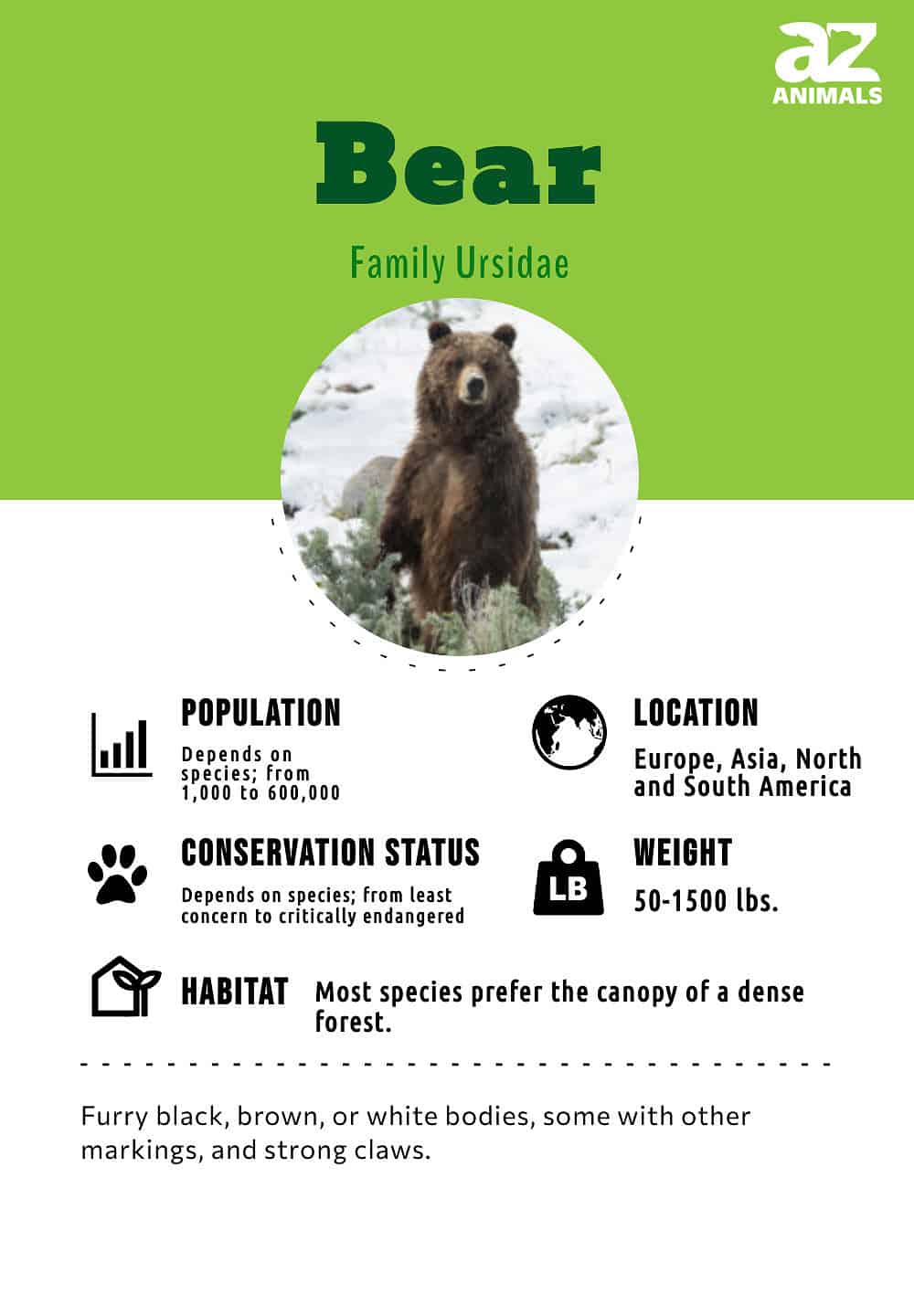
There are eight different species of bears across the world with a conservation status ranging from vulnerable to least concern. Depending on the bear species, habitats include North America, South America, Europe, Asia, and the northern-most polar regions. While not ordinarily a threat to humans, bears are animals that can be very dangerous if startled, provoked, or approached when young bears (cubs) are present.
4 Amazing Facts:
- While considered a carnivorous species, most bears eat vegetation as their primary food source. In fact, just 10% of a grizzly bear’s diet is meat!
- Polar bears are on average not just the largest bear species, but also the largest carnivorous land animal on Earth!
- Do NOT try to outrun a bear. Black bears can run up to 35 miles per hour, which is significantly faster than the fastest human ever. Even larger grizzly bears can reach speeds that top 30 miles per hour.
- Many bear experts believe bears can smell from up to 20 miles away.
Types – The 8 Different Species
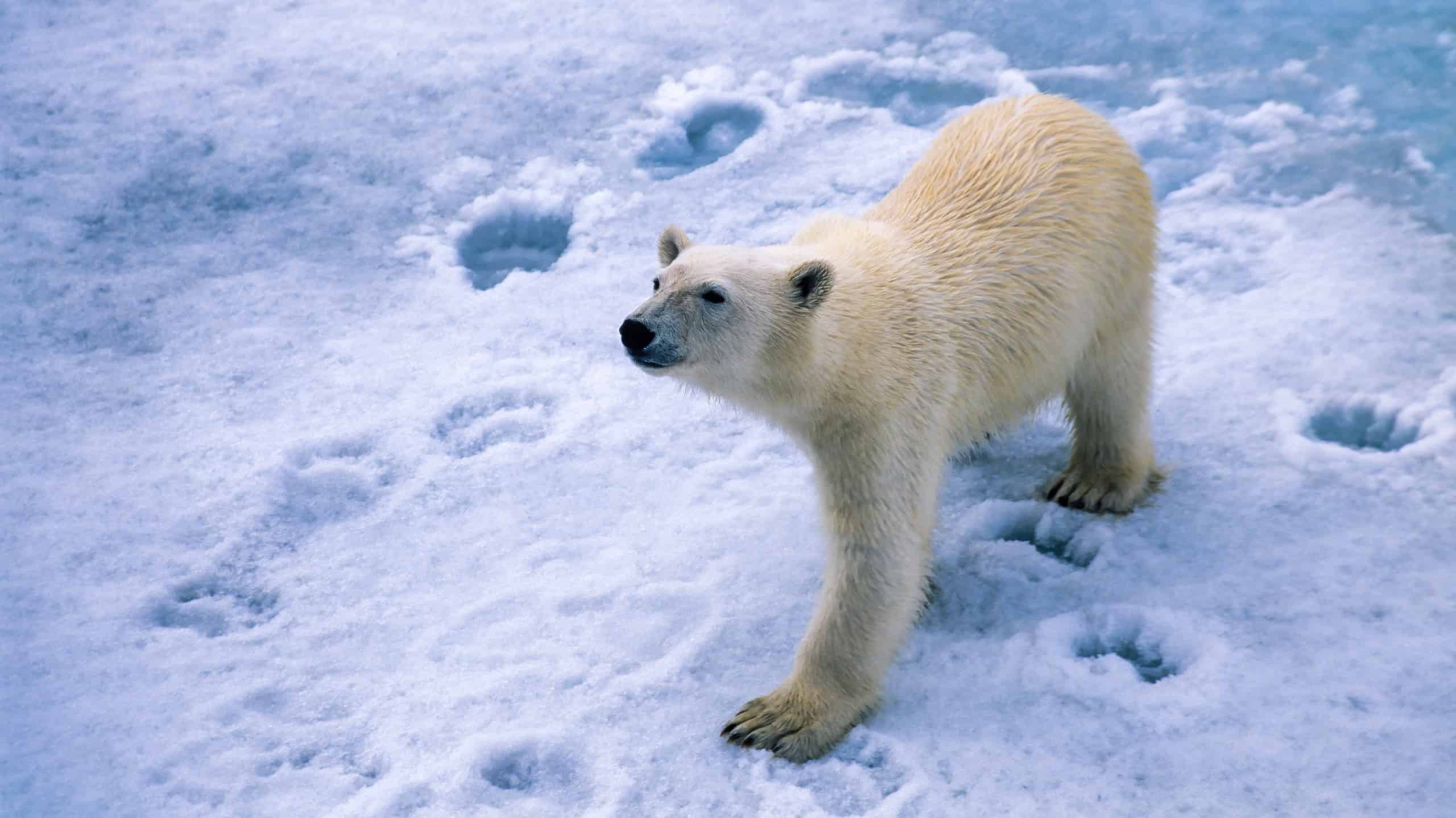
One of the eight unique species of bears is the Polar Bear found in the Arctic region.
©Lasse Johansson/Shutterstock.com
There are eight unique species of bears that vary in size, appearance and food preference. You can predominantly find them throughout North America, South America, Europe and Asia. The bear species include:
- Asiatic Black Bear (Asian Black Bear) – The Asiatic black bear, also referred to as the moon bear, is primarily an herbivore bear species found predominantly in Southern Asia, Afghanistan and parts of Japan. They are often found in trees in mountainous areas.
- Brown Bear – The brown bear, also referred to as the grizzly bear, is found in North America, Asia and Europe. It is distinguished by the humps that rest over its shoulders and massive brown physique. This bear species is the least likely to become extinct of all the bears, at this time.
- North American Black Bear – The North American black bear can be found from Northern Canada to Central Mexico. It does not have a climate preference. It will even feed on prickly pear cactus. This bear species prefers mountainous regions, but you will find them in meadows and wetlands, too.
- Polar Bear – Polar bears are found only in the Arctic region surrounding the North Pole. They travel by floating glacial ice blocks. As these ice packs melt, the threat to the existence of polar bears increases, making them highly susceptible to extinction.
- Spectacled Bear – The spectacled bear, also referred to as the Andean bear, enjoys spending time in trees. It is the only bear species to reside in South America. These bears are vulnerable to extinction because of human killing for profit and superstition.
- Panda Bear – The Panda bear might be the most well-known bear on the planet due to its adorable appearance. It primarily feasts on bamboo in Central China. Panda bears are considered endangered because of black market demand.
- Sloth Bear – The sloth bear receives its name from its similarities to the sloth animal. The long snout allows it to consume prey not typically associated with bears, including ants and termites. Sloth bears are found in India and Sri Lanka.
- Sun Bear – Sun bears are distinctive because of the cream, crescent markings on their chests. As they often eat bees’ nests, they are commonly referred to as honey bears. You can find them in Malaysia and Indonesia, and they are vulnerable to extinction due to deforestation.
Scientific Names And Evolution
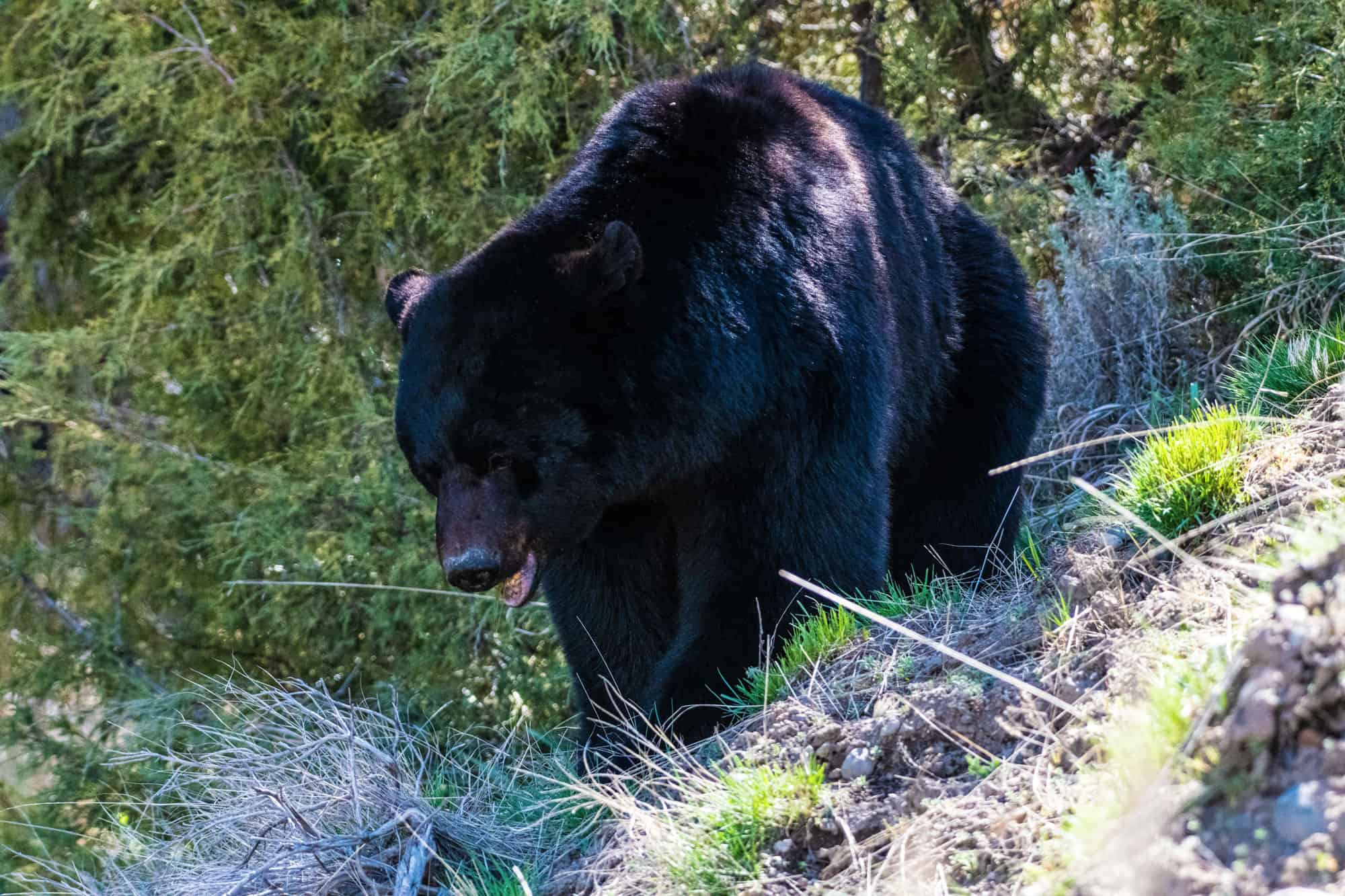
There are two species of black bear, the Asiatic and the North American, but the North American can be a lot bigger.
©iStock.com/John Morrison
The family name for bears is Ursidae. The Pandas belong to the subfamily Ailuropodinae, and the Spectacled bears belong to the subfamily Tremarctinae (which once included the now extinct American giant short-faced and Florida short-faced bears). All other bears belong to the subfamily Ursinae. Ursus, which means bear in Latin, is the genus. There are multiple subspecies as well. The following are the eight genus (or subfamily) and species names of bears:
- Asiatic Black Bear (Ursus thibetanus)
- Brown Bear (Ursus arctos)
- North American Black Bear (Ursus americanus)
- Polar Bear (Ursus maritimus)
- Spectacled Bear (Tremarctos ornatus)
- Panda Bear (Ailuropoda melanoleuca)
- Sloth Bear (Ursus ursinus)
- Sun Bear (Ursus Himalayanus)
The evolution of bears is relatively recent. They are the latest addition to carnivores, having evolved from small, dog-like mammals about 40 million years ago. In fact, it was only about 20 million years ago that bears became identifiably unique as Ursavus elmensis, or the dawn bear. It is thought that the subfamily Tremarctinae of the spectacled bear diverged from Ursinae about 5.7 million years ago. Later, 4-5 million years ago, black bears, brown bears, and polar bears diverged, according to DNA studies. Then bears began to travel across the Bering Strait approximately 1.3 million years ago.
Appearance & Behavior
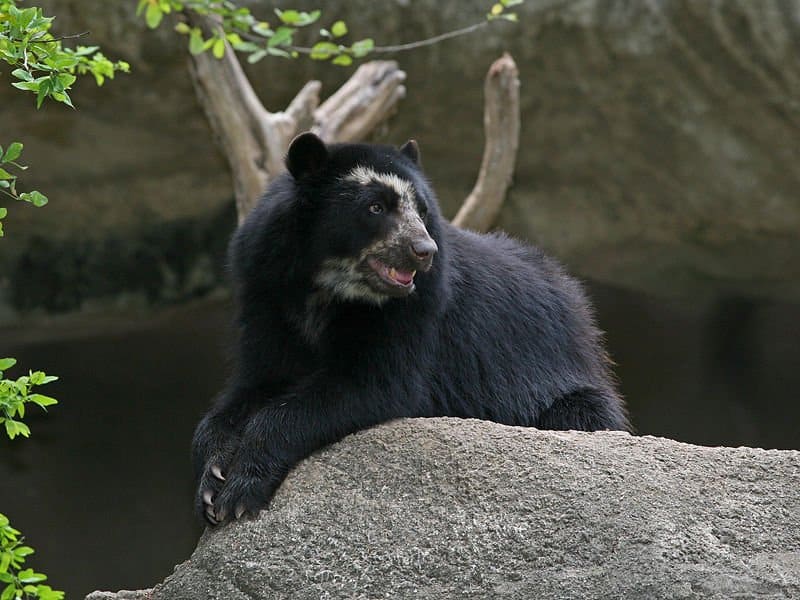
The Spectacled Bear has white around the eyes, making it look like it is wearing spectacles or goggles.
Bears are noted for their furry bodies and strong claws. Some climb trees, and others swim. Certain bear subspecies have even more distinctive markings around the eyes and on their chest that set them apart from the others.
Various species of bears have adapted to their environments over time. For example, polar bears are white to blend in with the snow, and North American black bears have versatile eating habits that include corn crops and cactus depending on their region of residence.
All bears have an acute sense of smell, hearing and sight. They often hear and smell humans before they see humans and flee as a result. Bears are solitary creatures by nature. However, mothers and cubs will travel together, and bears will travel in pairs during mating seasons.
The approximate weights of the various bear species are as follows:
- Asiatic Black Bear: 50 – 116 kg (110 – 255 lbs)
- Brown Bear: 93 – 410 kg (205 – 900 lbs)
- North American Black Bear 39 – 409 kg (86 – 900 lbs)
- Polar Bear 200 – 682 kg (440 – 1,500 lbs)
- Spectacled Bear 64 – 125 kg (140 – 275 lbs)
- Panda Bear 70 – 125 kg (155 – 275 lbs)
- Sloth Bear 55 – 141 kg (120 – 310 lbs)
- Sun Bear 22 – 50 kg (50 – 110 lbs)
Hibernation
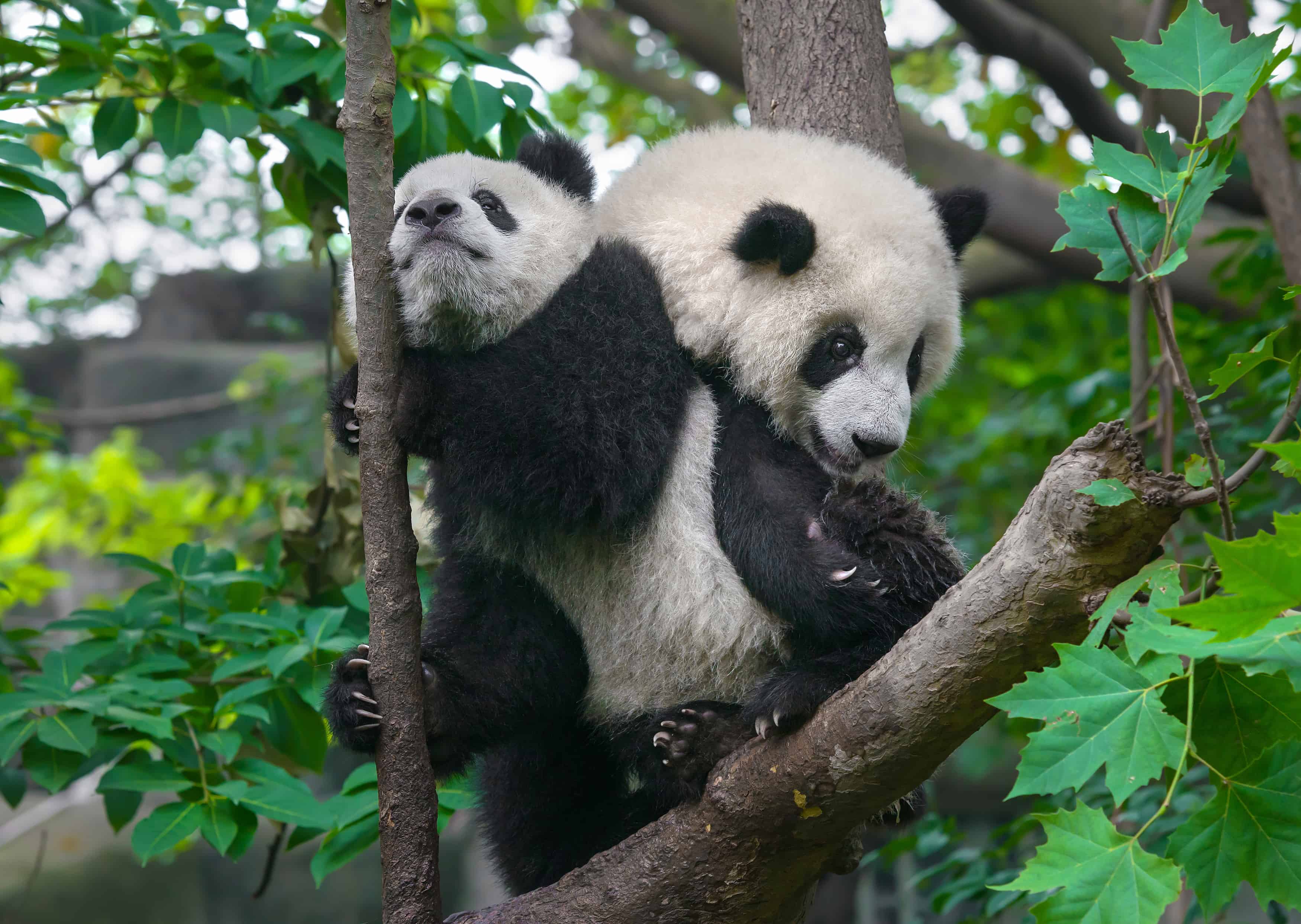
Giant panda bears do not hibernate but migrate with the seasons to follow food sources.
©iStock.com/Hung Chung Chih
Many species of bears will hibernate for long periods to save energy during winters when prey and other food sources are in short supply. Bears will hibernate in locations such as caves, hollowed-out trees, holes they dig in the ground, and dens that bears have dug in prior years. Before hibernating, bears will become hyperphagic, which means they’ll eat excessively to build energy reserves. For example, Himalayan black bears will reach up to 400 pounds before they hibernate. That’s significantly higher than their normal weight, which is between 200 and 265 pounds!
However, not all bear species hibernate. Panda bears will adjust their latitude throughout the year to find more abundant seasonal food rather than hibernating. Likewise, Asiatic black bears in southern climates will also skip hibernating. Finally, while polar bears do not hibernate; however, pregnant polar bears will construct maternity dens where they stay for long periods in a dormant state.
Habitats
The geographic regions of bear species are as diverse as their appearance. Most bear species prefer to live within the canopy of a dense forest. You can find bears throughout North America, Europe, Asia and Africa. They never made it to the Antarctic or Australia. While bears are curious by nature, many times, if they hear or smell a human, they will hide up a tree. Some bears prefer higher elevations, such as the Asiatic black bear, and others prefer coastal regions, such as polar bears. You will even find bears in desert climates, including the spectacled bears and American black bears. Bear populations that are unable to adapt to new habitats are vulnerable to extinction as their current homes are destroyed for development and for lumber.
Diet and Food
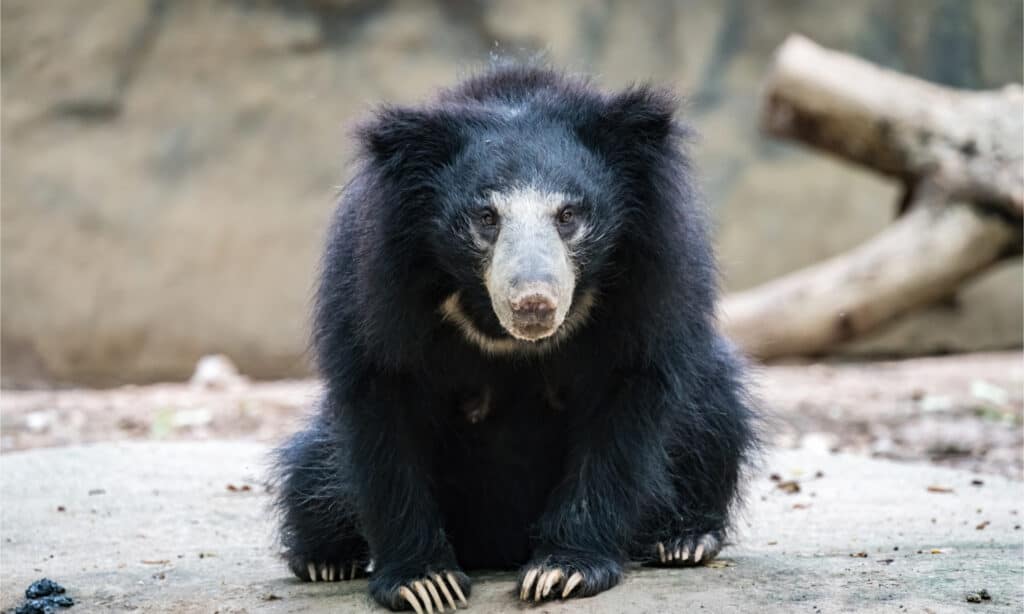
The Sloth Bear has a long snout for eating ants and termites.
©CJansuebsri/Shutterstock.com
Bears have proven they can survive on almost anything. Most bears eat vegetation; for example, the panda bear eats bamboo. However, many North American bears have adapted to their environments and will eat other animals and fish, including elk, caribou, and salmon. The polar bear, also referred to as the maritime bear, is a carnivorous animal as it typically eats seals, as well as whales and smaller walruses, on occasion. The sloth bear survives on ants and termites.
A growing concern exists for bears eating human food as it causes them to destroy property and even break into homes to seek out more of the same. Eventually, these bears are put down as they become an increasing threat to humans. This tragic result is avoidable as long as humans do not feed wild bears. On rare occasions, bears will eat a poisonous plant by mistake and die. Other than that, bears can eat almost anything to live.
Population
Today, all bear species are somewhat susceptible to extinction. Some bear species are more vulnerable than others. Asiatic black bears, polar bears, panda bears, sloth bears, and sun bears are all considered in danger of extinction. Brown bears are categorized as stable, and the American black bears are increasing in population and are considered of least concern at the moment.
- Asiatic Black Bear – Less than 50,000
- Brown Bear – 200,000
- North American Black Bear – 600,000
- Polar Bear – 20,000 to 25,000
- Spectacled Bear – Less than 2,000
- Panda Bear – 2,000
- Sloth Bear – 7,000 to 10,000
- Sun Bear – Unknown, possibly less than 1,000
Extinction
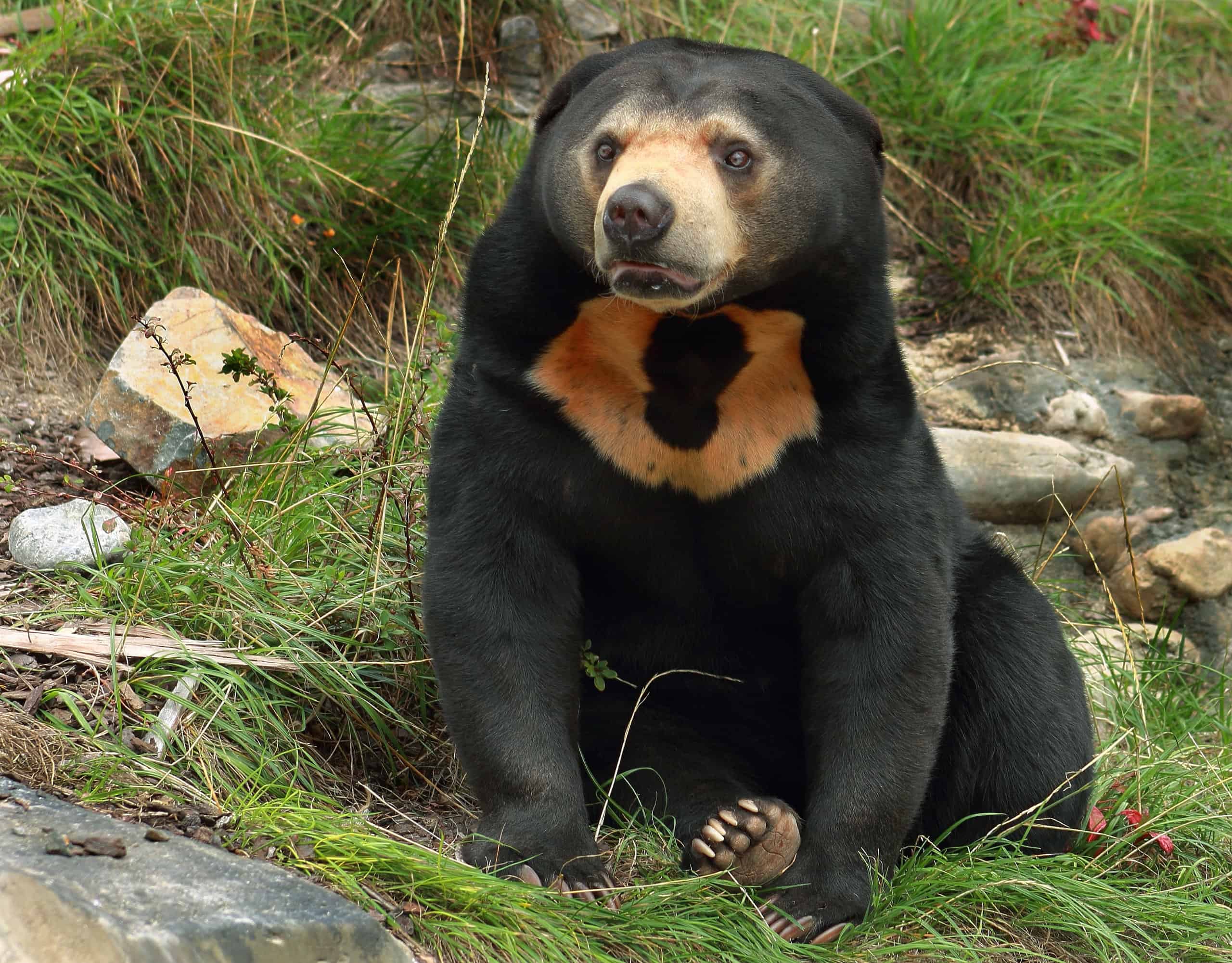
The Sun Bear, which has a distinctive chest mark and a population of only about 1,000, is the closest to extinction of any of the bear species.
©Molly NZ/Shutterstock.com
While several bear species of today are vulnerable to extinction, only a few bear species or subspecies have become extinct in recent history. This includes the Californian grizzly bear in the 1920s and the Mexican grizzly bear in the 1960s. Both became extinct due to hunting. The same is true of the Atlas bear, the only bear native to Africa. It was hunted to extinction in the 1870s.
The giant panda bear was near extinction in recent times when drastic efforts were made to save the species. Many scientists believe the polar bear is under severe threat due to climate change. Their existence may be directly connected to their ability to adapt.
Among the bear species that are extinct are the giant short-faced bear and cave bears. The giant short-faced bear was a carnivorous animal that stood 12-feet high, ran over 40 mph, weighed over 1,500 pounds and lived in the northern half of North America. It became extinct around the end of the Ice Age due to loss of habitat. Cave bears resided in much of Europe but died out around 25,000 years ago before the last Ice Age began. They were believed to weigh up to 1,500 pounds just like the short-faced bear.
Predators and Threats
Bear cubs are particularly susceptible to any number of predators, such as coyotes and wolves; however, adult bears experience very few natural predators. The primary predators that target bears are other bears and humans. Illegal bear hunting is likely the greatest predator. Some cultures poach bears for their meat and various body parts and organs to sell on the black market. Environmental change is another significant threat to bears, their natural habitats, and their food sources. Also, human deforestation and development are threatening many bear species and subspecies.
Mating, Babies, and Lifespan
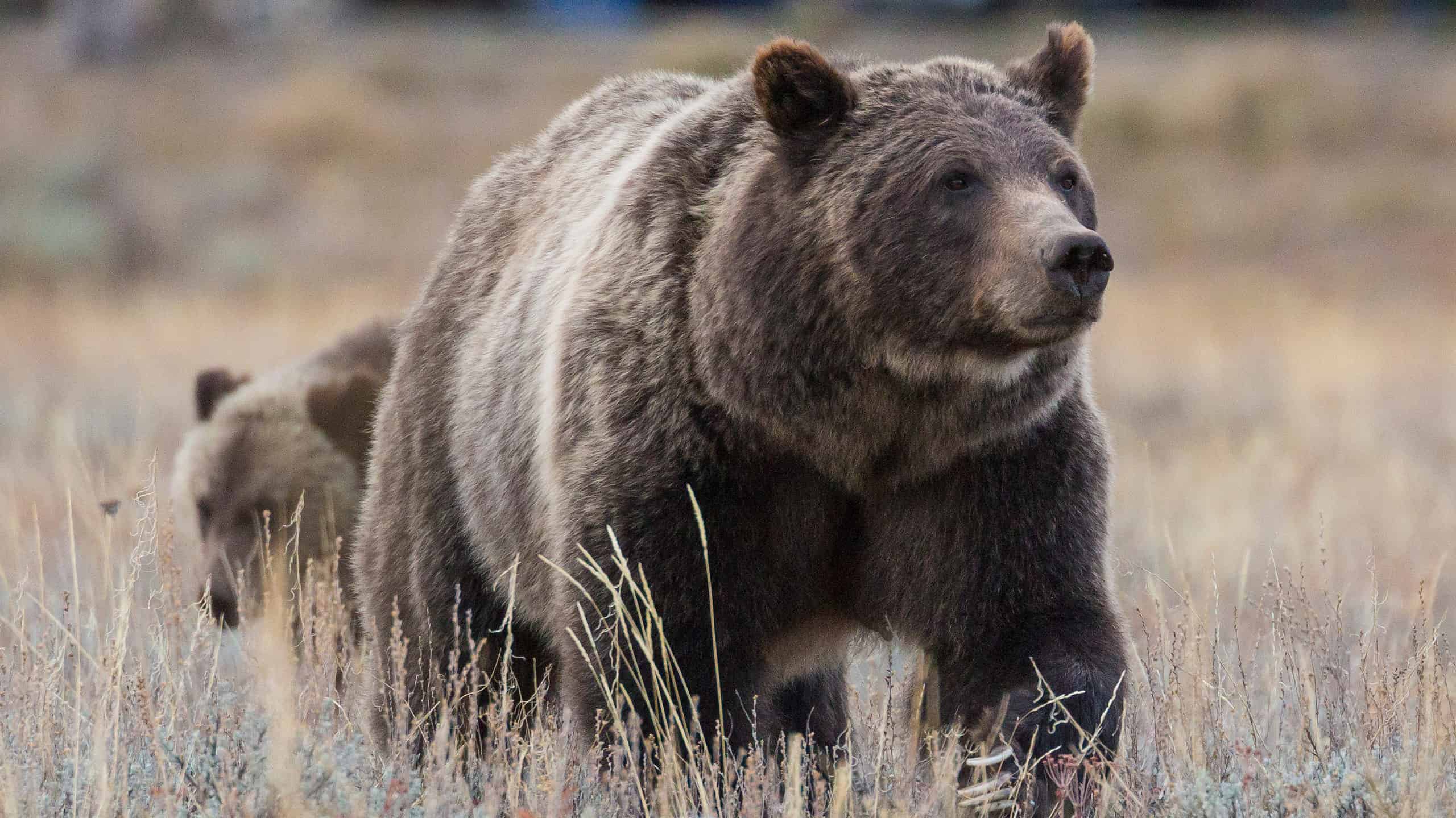
This Grizzly and her cub are members of a subspecies of brown bear and can expect to live for 30 years.
©BlueBarronPhoto/Shutterstock.com
A courting process does occur between a male and a female bear during the spring. Male bears are promiscuous and will mate with several female bears, if possible, over time. Only the largest males will mate due to because of the high level of competition. Because of this competition, female bears will also take on several partners in their lifetimes. However, during the courting and mating process, both bears became nearly inseparable. The season of breeding and mating lasts from May to early July. Females typically give birth in January and February.
Female bears mate and experience a fertilized eggs and embryos much like humans. They will give birth to between one and six bear cubs, but usually just one to three. Mother bears are quite affectionate and protective. They will care for and den with their cubs for up to three years, often less. During this time, the cubs will feed on the mother’s milk and food gathered by their mother and themselves. When it is time to separate, the cubs do not take it well. As a result, siblings often stay together for a duration after the initial separation.
The average lifespan of each bear species varies, including:
- Asiatic Black Bear – 25 to 30 years, Oldest on Record: 42 years
- Brown Bear – 20 to 30 years, Oldest on Record: 40 years
- North American Black Bear – 20 years, Oldest on Record: 39 years
- Polar Bear – 20 to 30 years, Oldest on Record: 45 years
- Spectacled Bear – 20 years, Oldest on Record: 37 years
- Panda Bear – 15 to 20 years, Oldest on Record: 38 years
- Sloth Bear – 20 years, Oldest on Record: 27 years
- Sun Bear – 25 years, Oldest on Record: 34 years
It is important to note that most bear species live longer in captivity than in the wild. The averages listed above represent the average lifespan of a wild bear. The oldest age on record is representative of any bear regardless of being wild or captive. As bears age, their health begins to decline just as with humans, including dental health, eyesight, and an overall dulling of the senses. This decline greatly affects their quality of life and ability to survive.
More:
- Bears Gestation Period: How Long Are Bears Pregnant?
- Discover the Largest Bear to Ever Exist (Up to 4X The Size of a Grizzly!)
Bear FAQs (Frequently Asked Questions)
Would a bear or shark win in a fight?
While this question may sound ridiculous on the surface, consider that orcas often eat moos. So, stranger things have happened in the animal kingdom! If a bear and shark met, it’s likely the shark would have the advantage. Bears will hunt salmon in the water, but they’re ill-adapted for battling an apex predator of the seas.
Are Bears and Dogs Related?
The short answer is that dogs and bears are not directly related. The longer answer is that bears and dogs shared a common ancestor that lived 62 to 32 million years ago. Today they’re from the same sub-order, which split from cats and includes a number of omnivores that also include raccoons, foxes, and wolves. So while they’re not related, they are more closely related than many would believe!
Are Bears carnivores, herbivores or omnivores?
Most bears select their food source by adapting to their environments. While the panda bear is primarily a herbivore, it occasionally eats rodents or birds and is therefore considered an omnivore. The sun bear, North American black bear, brown bear, and Asiatic black bears are also omnivores. The polar bear is strictly carnivorous.
What Kingdom do Bears belong to?
Bears belong to the Kingdom Animalia.
What phylum do Bears belong to?
Bears belong to the phylum Chordata.
What class do Bears belong to?
Bears belong to the class Mammalia.
What family do Bears belong to?
Bears belong to the family Ursidae.
What order do Bears belong to?
Bears belong to the order Carnivora.
What genus do Bears belong to?
Bears belong to the genus Ursus.
What type of covering do Bears have?
Bears are covered in Fur.
In what type of habitat do Bears live?
Bears live in forests and mountainous regions.
What is the main prey for Bears?
Bears prey on fish, nectar, and insects.
What are some distinguishing features of Bears?
Bears have large teeth and paws and strong bodies.
What are some predators of Bears?
Predators of Bears include humans, wolves, and wildcats.
What is the average litter size for a Bear?
The average litter size for a Bear is 2.
What is an interesting fact about Bears?
There are 8 different Bear species!
What is the scientific name for the Bear?
The scientific name for the Bear is Ursidae.
What is the lifespan of a Bear?
Bears can live for 15 to 35 years.
How fast is a Bear?
A Bear can travel at speeds of up to 35 miles per hour.
Are bears related to dogs?
Both animals are not directly related. Dogs and bears are both within the suborder Caniformia but they belong to different families.
Who would a fight between a bear and a Komodo dragon?
A bear would beat a Komodo dragon in a fight, but it might get bloody. The problem that Komodo dragons face is that they are very short compared to a bear. For example, if a Komodo dragon approached a grizzly bear, the bear would stand on its legs to appear bigger and scare it away.
Who would win a fight between a moose and a bear?
A bear would win a fight against a moose in the vast majority of cases. Bears know how to track down and kill moose when they are young and juveniles. They’re also familiar with hunting and killing adult moose, too.
Who would win a fight between a mountain lion and a bear?
A bear would beat a mountain lion in a fight. These creatures have no venom or special attacks, so this fight is not likely to be over in a single blow. Thus, it’s a knock-down, drag-out fight where the bigger, stronger, and deadlier creature wins. The bear fits the bill better than the mountain lion.
How to say Bear in ...
Thank you for reading! Have some feedback for us? Contact the AZ Animals editorial team.
Sources
- David Burnie, Dorling Kindersley (2011) Animal, The Definitive Visual Guide To The World's Wildlife
- Tom Jackson, Lorenz Books (2007) The World Encyclopedia Of Animals
- David Burnie, Kingfisher (2011) The Kingfisher Animal Encyclopedia
- Richard Mackay, University of California Press (2009) The Atlas Of Endangered Species
- David Burnie, Dorling Kindersley (2008) Illustrated Encyclopedia Of Animals
- Dorling Kindersley (2006) Dorling Kindersley Encyclopedia Of Animals
- David W. Macdonald, Oxford University Press (2010) The Encyclopedia Of Mammals

















